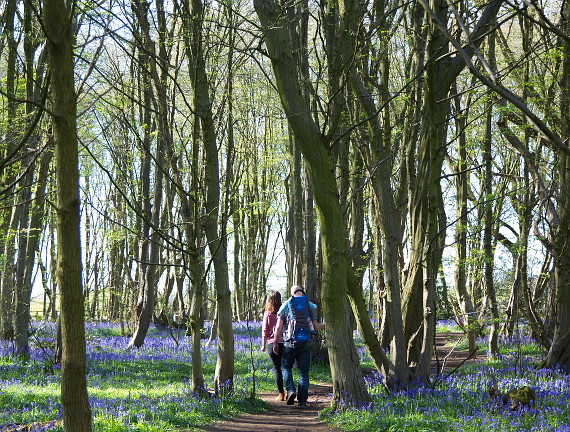Heartwood’s bluebells – keeping the magic alive
Every spring the floor of the ancient woodlands at Heartwood Forest is transformed into a mass of fragrant bluebells. This spectacular carpet of vibrant blue captures the very essence of British woodland.
Bluebells are the bounty of spring. We encourage you to get out and enjoy what they have to offer, but watch where you put your feet. Over recent years, over an acre of bluebells have been lost in Langley Wood at Heartwood (equivalent to over half the size of Wembley football pitch). This is due to visitors wandering off the paths and trampling the bluebells.
You can play your part in securing a bright future for these blue woodland beauties by:
• Sticking to the waymarked paths
• Ensuring dogs stick to the paths too – dogs can also damage bluebells through trampling
• Using the designated den-building area for honing your family survival skills.
Remember, bluebells are vulnerable to trampling all year round, not just when they’re flowering in spring, so watching your step throughout the seasons is important.
Getting to Langley Wood
The bluebell displays in Langley Wood are a favourite with many of our visitors, and now accessing this springtime spectacle is even easier, as the paths through Langley have an all-weather surface (carefully installed to avoid damage to the woodland). View the map, showing two possible routes to Langley Wood from the main Heartwood Forest car park.
Please see our access guide for more information on access across the wider site.
Trampling: the facts
• Bluebells are particularly sensitive to trampling
• Once damaged, leaves are unable to produce food to put back into their bulbs which means they're less able to produce flowers
• Large bluebell colonies take a long time to establish; each plant takes around 5-7 years to flower from seed
• After repeated tramplings, bluebells are unable to produce seeds
• Woodlands take many years to regenerate from trampling damage.
Bluebell fact file
Common name: bluebell
Scientific name: Hyacinthoides non-scripta
Family: Asparagaceae
Also known as: English bluebell, British bluebell, wild hyacinth, wood bell, fairy flower, bell bottle
• One fifth of the world’s bluebells grow here in the UK
• Bluebells are more commonly found in ancient rather than new or semi-mature woodland
• Bluebells are important early flowers for bees, hoverflies and butterflies which feed on the nectar.

Bluebells produce a spectacular carpet in spring (Photo: Judith Parry/WTML)

Enjoy the bluebells but please keep to the paths to minimise damage (Photo: Judith Parry/WTML )

(Photo: Judith Parry/WTML)
